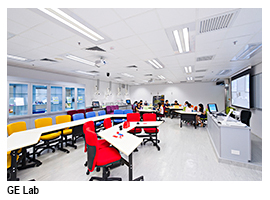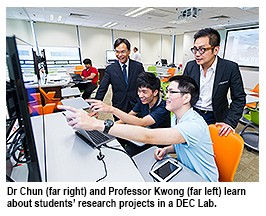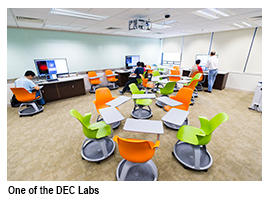New labs to boost students’ innovation and creativity
by Christina Wu and Joan Yip
New learning spaces at City University of Hong Kong (CityU) in support of the Discovery-enriched Curriculum (DEC) will give students the chance to create, test and communicate ideas for more creative and interactive learning. The new facilities are the Gateway Education Laboratory and the Discovery-enriched Curriculum Labs.
Gateway Education Laboratory (GE Lab)

“This new GE Lab provides a venue for students from science and non-science disciplines to get their hands wet and transform their dream designs into prototypes,” said Professor Cheng Shuk Han, Director of the Office of Education Development and Gateway Education.
“We believe the equipment we installed in the lab will let students experience the thrill of seeing their ideas come to life,” she added.
The GE Lab is one of several University initiatives that support DEC, which is designed to motivate and ignite a passion for knowledge and discovery among students. The purpose-built GE Lab provides more than 170 square metres in which students can develop innovative ideas as part of their GE courses. These facilities include:
· Two 3D printers and a 3D scanner, which allow students to transform innovative designs and models into physical objects
· A digital Show-and-Tell Studio composed of cameras and a 70-inch presentation touch panel that allows students to showcase their discoveries and display them online, and practice their communication skills
· A scanning electron microscope which magnifies micro objects up to 60,000 times, encouraging students to explore the micro and nano world
· Two 40-inch interactive table panels each with a 52-point touch sensor which allows a group of students to engage in interactive teaching and learning activities

Under the four-year curriculum, students need to complete 30 credits of GE courses, which make up 25% of the total credits required for graduation. The GE Lab will complement the existing labs in the College of Science and Engineering, the language labs and the facilities in the Run Run Shaw Creative Media Centre to enrich student learning, according to Professor Cheng.
Discovery-enriched Curriculum (DEC) Labs

The new reconfigurable learning-spaces are equipped with easily arrangeable chairs, walls with writable surfaces that also double as multi-media display surfaces, flat-panel TVs, wireless computing devices and motion capturing sensors, representing close to $4 million in investment. In this engaging learning environment, students are able to actively work in teams and closely interact with each other in solving programming and other computing-related problems.
The highly flexible layout in the DEC Labs, according to Dr Andy Chun Hon-wai, Chief Information Officer, is designed from a student-centred approach to facilitate collaboration, teamwork, communication and problem solving.

A teaching and learning questionnaire conducted by the University shows very encouraging feedback from the students. They described the lab sessions as “fun and exciting” and “providing a chance to make discoveries by themselves”.
“The DEC Labs enhance students’ interest and know-how on computing. Most importantly, the Labs help to nurture an inquisitive mind in the students,” said Professor Sam Kwong Tak-wu, Head of the Department of Computer Science.
1,200 to 1,400 students will benefit from the new learning spaces every year, Professor Kwong added.